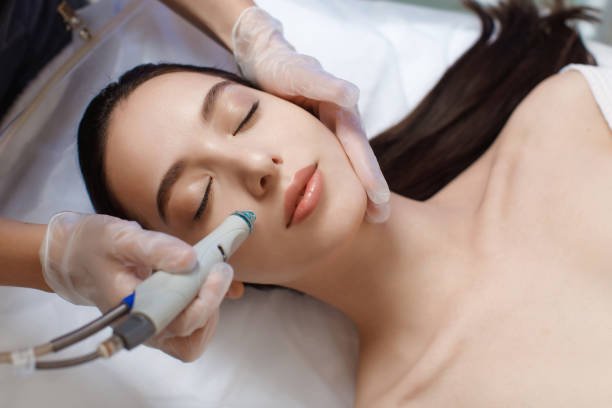Hydrafacial treatments have gained popularity for their ability to rejuvenate the skin, deeply cleanse pores, and promote a glowing complexion. However, some people experience a surprising issue after the procedure—their skin looks worse. If you’ve undergone a Hydrafacial and are dealing with breakouts, redness, or dullness, you’re not alone. In this article, we’ll explore why Skin Looks Worse After Hydrafacial, what to expect during the recovery phase, and how you can ensure optimal results.
What Is a Hydrafacial and How Does It Work?
Before diving into the reasons why your skin looks worse after a Hydrafacial, it’s important to understand the basics of the treatment. A Hydrafacial is a non-invasive, multi-step skincare procedure that uses a patented device to cleanse, exfoliate, extract impurities, and hydrate the skin all in one go.
The Key Steps of a Hydrafacial Include:
- Cleansing and Exfoliation: Removes dead skin cells and surface impurities.
- Acid Peel: Gently exfoliates deeper layers of the skin.
- Extraction: Uses a vacuum-like device to unclog pores.
- Hydration: Infuses the skin with serums rich in antioxidants and peptides.
The goal of a Hydrafacial is to leave the skin radiant, smooth, and healthy. But sometimes, things don’t go as planned.
Why Skin Looks Worse After a Hydrafacial
It might feel alarming if your skin looks worse after a Hydrafacial, but there are several reasons why this could happen. Let’s explore some of the most common factors.
1. Purging: Your Skin Detoxifies
One of the primary reasons for skin looking worse after a Hydrafacial is skin purging. This is a process where the skin brings underlying impurities, such as trapped sebum and toxins, to the surface. While this can result in breakouts or irritation immediately after the treatment, it’s actually a good sign.
When your skin purges, it’s expelling everything that was congesting your pores. After this initial period, your complexion is likely to clear up, leaving you with smoother and healthier skin.
Key Signs of Skin Purging:
- Small, inflamed pimples
- Redness or irritation in areas where breakouts typically occur
- Dryness or flakiness
Skin purging is a temporary phase that can last up to a week but often clears up sooner.
2. Post-Treatment Redness and Sensitivity
It’s also common for your skin to be red and sensitive immediately after a Hydrafacial. This happens because the treatment involves exfoliating and extracting impurities from your skin. These processes can cause temporary inflammation, especially if your skin is more sensitive than average.
If your skin looks worse after a Hydrafacial, the redness and sensitivity should subside within 24-48 hours. During this time, it’s crucial to keep your skin hydrated and avoid harsh skincare products that could exacerbate irritation.
How to Soothe Redness and Sensitivity:
- Apply a gentle, hydrating serum or moisturizer.
- Avoid sun exposure and wear sunscreen.
- Use a cool compress to calm inflammation.
3. Over-Exfoliation: Too Much of a Good Thing
While a Hydrafacial is designed to be a gentle treatment, it’s possible for your skin to react negatively if it’s been over-exfoliated. Over-exfoliation can strip away your skin’s natural barrier, leading to dryness, irritation, and sensitivity. If your skin looks worse after a Hydrafacial, this could be the culprit.
To prevent over-exfoliation, it’s important to space out your treatments appropriately. For most skin types, getting a Hydrafacial once a month is sufficient. Be sure to follow your dermatologist’s recommendations based on your individual skin needs.
How to Recover When Your Skin Looks Worse After a Hydrafacial
If your skin is reacting poorly after a Hydrafacial, don’t panic. Here are some practical steps you can take to help your skin recover quickly and get back on track toward glowing, healthy results.
1. Hydrate, Hydrate, Hydrate
One of the most effective ways to soothe irritated skin is by keeping it well-hydrated. Use a gentle, fragrance-free moisturizer to lock in moisture and prevent further irritation. Drinking plenty of water will also help keep your skin hydrated from the inside out.
2. Use Gentle Skincare Products
While your skin heals, it’s essential to avoid harsh exfoliants or active ingredients such as retinoids and strong acids. Stick to products that are hydrating and soothing. Look for ingredients like hyaluronic acid, aloe vera, and ceramides, which can help restore your skin’s barrier.
3. Avoid Sun Exposure
After a Hydrafacial, your skin is more vulnerable to sun damage, which can make it look worse. Be sure to apply sunscreen with at least SPF 30 every day, even if you’re indoors, to protect your skin from UV rays. Wearing a hat and seeking shade when outdoors can further prevent irritation.
4. Consult with a Skincare Professional
If your skin’s condition doesn’t improve after a week or two, it may be time to consult with your dermatologist or esthetician. They can assess your skin’s reaction and recommend specific treatments or products to speed up recovery.
How to Prevent Skin from Looking Worse After a Hydrafacial
Prevention is key to ensuring your skin stays healthy and radiant after a Hydrafacial. Here are some tips to help you avoid issues in the future.
1. Consult a Qualified Practitioner
Choosing an experienced professional to perform your Hydrafacial is crucial. They will know how to tailor the treatment to your skin type, avoiding issues like over-exfoliation or improper extraction techniques. Always check credentials and reviews before booking a session.
2. Follow Aftercare Instructions
Aftercare is just as important as the treatment itself. Be sure to follow any aftercare instructions provided by your esthetician, such as avoiding makeup, staying hydrated, and steering clear of harsh skincare products.
3. Start with Fewer Treatments
If you’re new to Hydrafacials or have sensitive skin, consider starting with fewer treatments to see how your skin reacts. Your esthetician may recommend beginning with a gentler version of the treatment to avoid overloading your skin.
Common Misconceptions About Hydrafacials
Let’s clear up a few misconceptions that might be causing concern if your skin looks worse after a Hydrafacial.
1. Hydrafacials Aren’t for Everyone
While Hydrafacials can benefit most skin types, they’re not suitable for everyone. If you have certain skin conditions, such as rosacea or active acne, a Hydrafacial might aggravate the issue. Consult with your skincare professional before undergoing treatment if you have any concerns.
2. Instant Results Aren’t Always Guaranteed
While many people experience glowing skin immediately after a Hydrafacial, it’s not uncommon for others to go through a “downtime” period. If your skin looks worse initially, it’s often part of the process as your skin clears itself of impurities and begins to heal.
When to Seek Professional Help
If you’re noticing prolonged issues such as severe breakouts, lasting redness, or increased skin sensitivity after a Hydrafacial, it’s important to consult a dermatologist. Persistent symptoms might indicate an allergic reaction or an underlying skin condition that needs addressing.
Signs You Should Seek Help:
- Severe, painful breakouts
- Redness lasting more than 3 days
- Persistent swelling or itching
Hydrafacials are generally considered a safe and effective skincare treatment, but sometimes your skin looks worse after a Hydrafacial due to purging, over-exfoliation, or sensitivity. By understanding these potential issues and following the proper aftercare, you can ensure your skin recovers quickly and looks its best.











































